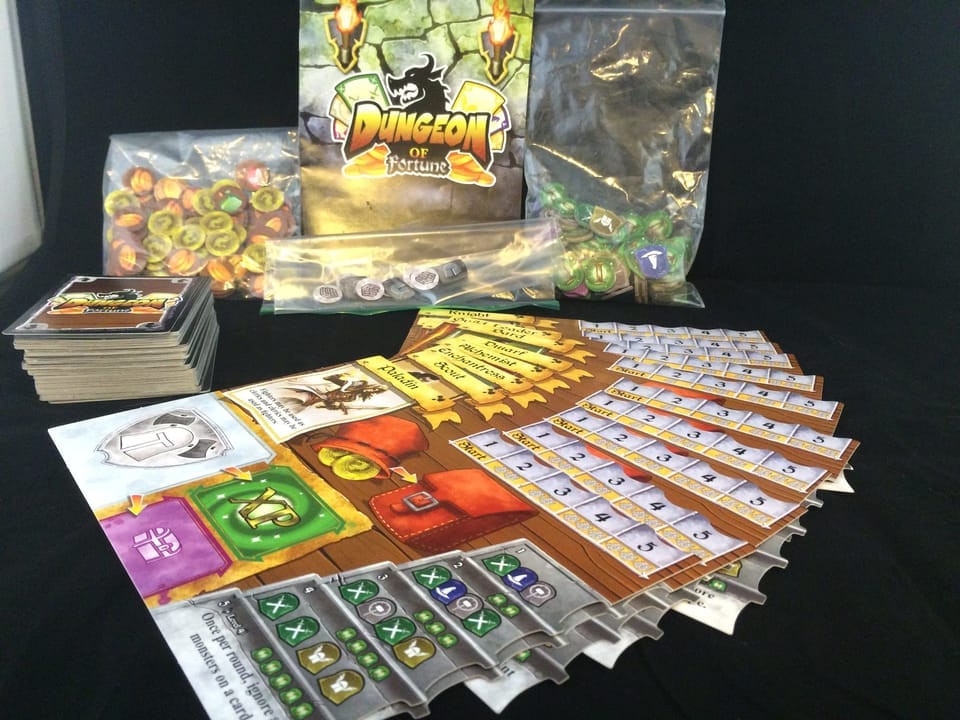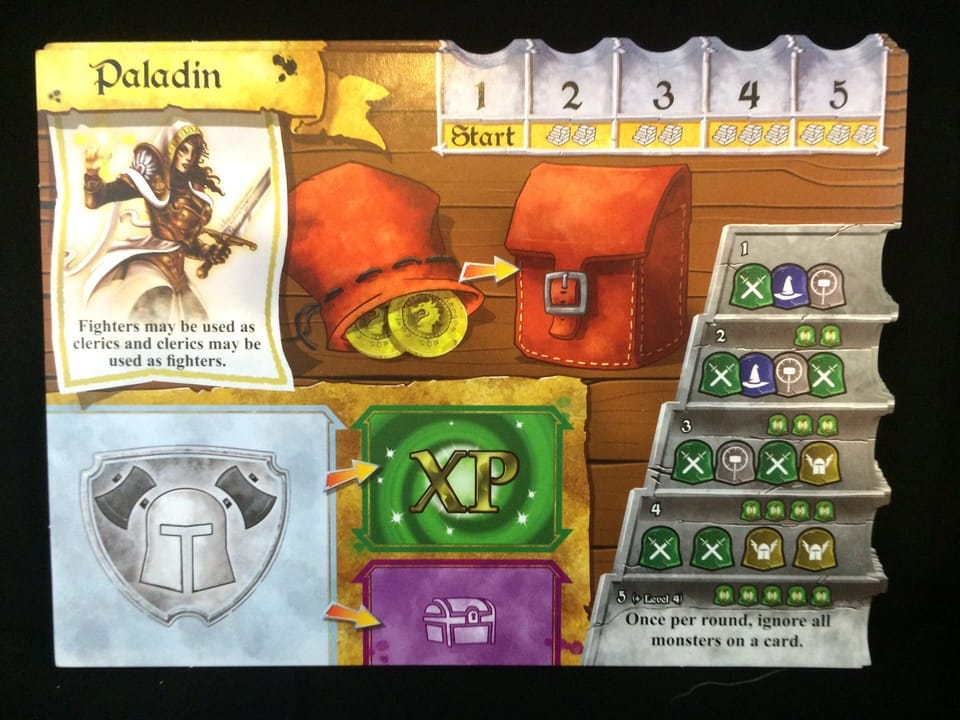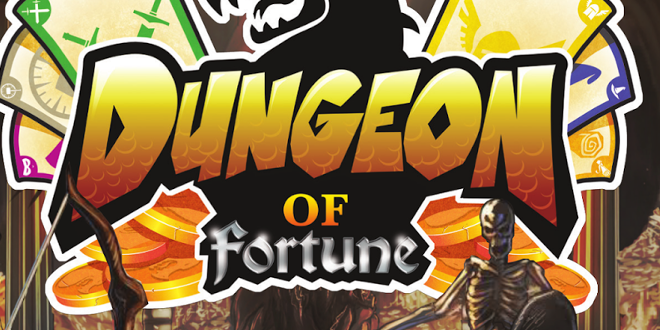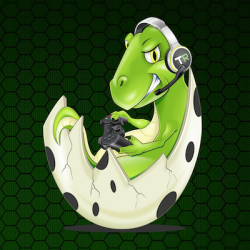Hello, TechRaptor readers. Rather than reviewing a tabletop wargame, we’ll be taking a look at a traditional board game. Dungeon of Fortune is a new game from Tasty Minstrel Games that tries to recreate the feeling of a good old-fashioned dungeon crawl. You’ll be hacking through goblins, skeletons, and dragons, opening treasure chests, and trying not to die and lose your hard-earned loot. It does a rather mediocre job of this, but a surprise does lurk beneath the surface.

The only real issue I have with the box contents is the instruction manual. The booklet itself has a decent production quality, but the rules and layout could definitely use some cleaning up. Many of the rules are unclear or poorly worded, and one rule (use of the scroll cards) was left out of the rulebook entirely for some reason. For such a simple game, it took my wife and I way longer than it should have to work out the rules. It also made trying to tech the game to our kids more troublesome than it should have been (more on that later).
Gameplay is rather simple and straightforward. Each player chooses a specific character that has a set ability, a set number and type of party characters, and a set dungeon progression track. The abilities themselves vary in usefulness and their uses come into play only occasionally, though it can at times mean the difference between victory and defeat. The only exception to this rule is the Guild Master character, who gets an additional party member at the start of the game. Depending on how your luck with the cards goes, it can sometimes lead to a near-insurmountable lead for the player using it. The randomness of the card deck can mitigate this somewhat, but it still feels more unbalanced. I'd personally recommend avoiding the Guild Master character for the most part because of this.

The players will get a set number of party members to join them, with the type and quantity increasing and changing as the character levels up. Each party member is matched by color with a specific monster and dragon type, meaning they can remove multiple monster types of the same color, or one of any other color. Thieves can open multiple treasure chests but only kill one monster, while champions can pretty much do anything. This means very little at early character and dungeon levels, but can be a major factor as the game progresses. Dragons are also roaming the dungeons, though they have a slightly different mechanic than anything else.
Dragon encounters only happen after the third time you draw a dragon card; the first two cards are treated as warnings. Dragons require either three heroes or two characters of the same color to defeat; killing a dragon gives you both a good amount of XP (2-3 depending on how you went about killing it) along with a loot bonus as well. If you don't have enough heroes in your party to dispatch the dragon, your only option is to run away and ditch all the loot you've acquired that round.
Game rounds are divided up into “delves.” Each player takes a turn flipping over a card from the deck and acting on it, whether it’s killing monsters, opening treasure chests, or stealing the loot from other players via the “Pilfer” card. Why that card exists in this game, I have no idea. If the game included some sort of gear mechanic as well to better equip players and heroes, I could see the usefulness of the card. As it stands now, though, it really doesn't do much aside from act as a very ineffective way to slow down the runaway success of one player (who probably ignored the "No Guild Master" house rule because he's That Guy) who's managed to build up an impressive stack in their satchel.
Players also have the chance of running into a dragon during their dungeon delves, which will require anywhere from 2-3 party members to defeat. Killing monsters gives players XP, opening chests gives players loot, and killing dragons gives both. When a player has exhausted their supply of party members, it’s time to stash their loot, level their characters up, and see if they can go deeper into the dungeon. This is done by collecting dungeon cards with staircases in the corners. Collect enough of these during a delve and you can advance into more difficult dungeon levels for more loot and XP. We think. Again, it's somewhat hard to tell if you're supposed to keep the stairway cards or discard them at the end of a delve because, again, the manual is lacking in clarity at times. The last person remaining gets a loot bonus, which works to prevent players from running out to stash too often. Again, this will most likely be That Guy playing the Guild Master if you didn't house rule it out of the game. Which you should, honestly.
Dungeon of Fortune also has a small press-your-luck element to it as well. Should a player find themselves unable to fight off a monster or dragon, their only option is to run away, giving up all loot and XP they’d earned during their delve and forced to sit out until all other players have stashed their loot. In theory it’s a good system, but it’s simply too easy to avoid by not drawing another card when you’re running low on party members. There’s still the chance you could run into a dragon, but they way dragon cards work make it less of a threat if you haven’t drawn any yet.
Each game has an amount of loot tokens determined by the number of players. Once the last loot token has been awarded, the game ends automatically. Players count the number of points they’ve acquired, with each loot token being worth anywhere from 1-3 points, along with gems and XP to determine the winner.
After the first few games between my wife and I, we were both ready to write it off as a rather forgettable game that is too shallow and simple for most gamers to appreciate. That changed when we decided to let our 8-year old daughter join in after noting the game is for ages 8 and up. Here is where I think the game truly shines. While the overall game complexity is lacking and some mechanics feel half-hearted for an adult, they fit in perfectly for a child. Kids get the enjoyment of playing a “grown-up” board game without a large amount of hand-holding after the first walkthrough. Dungeon of Fortune is an excellent gateway drug for small kids to get deeper into board games beyond Monopoly and Sorry. I'd even go as far as to say it's a better introduction to tabletop games than Settlers of Catan Junior.
A note about the score I've given for this game: Our site won't allow me to give two different scores, which is rather necessary for this game in my opinion. So here's how things will work this time: The final score listed is not what you should go by; that number is the midpoint between the two scores I believe it needs. If you have kids in the 8-10 age range who want to try a more "grown up game", add 1 to the final review score. If you don't have kids in this age range, then subtract 1.
Pros:
- Quick game play; games last about 20-30 mins
- Lots of replay ability with different characters
- Small box is easy to store with other games
Cons:
- Rule book is poorly laid out and is missing rules
- Press your luck mechanic easy to avoid
- Pilfer mechanic feels out of place
- Shallow-feeling gameplay may not scratch your itch
The copy of Dungeon of Fortune used for this review was provided by Tasty Minstrel Games.
Review Summary
A quick and easy tabletop game that kids can master easily and will enjoy, but will leave adults wanting more.
(Review Policy)Have a tip, or want to point out something we missed? Leave a Comment or e-mail us at tips@techraptor.net













